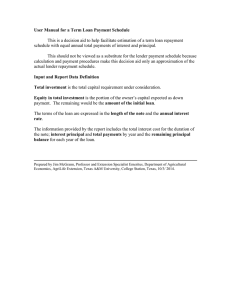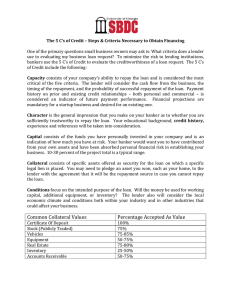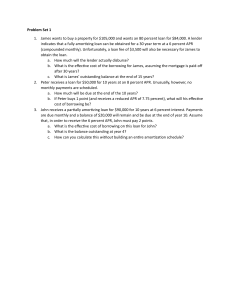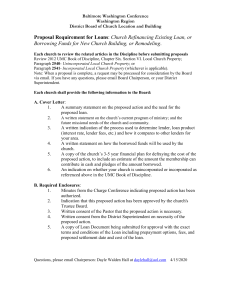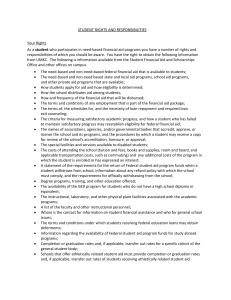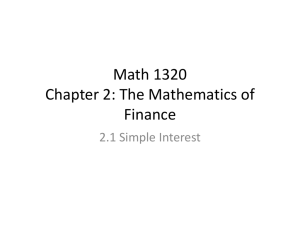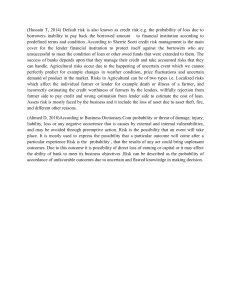Simple Interest
advertisement
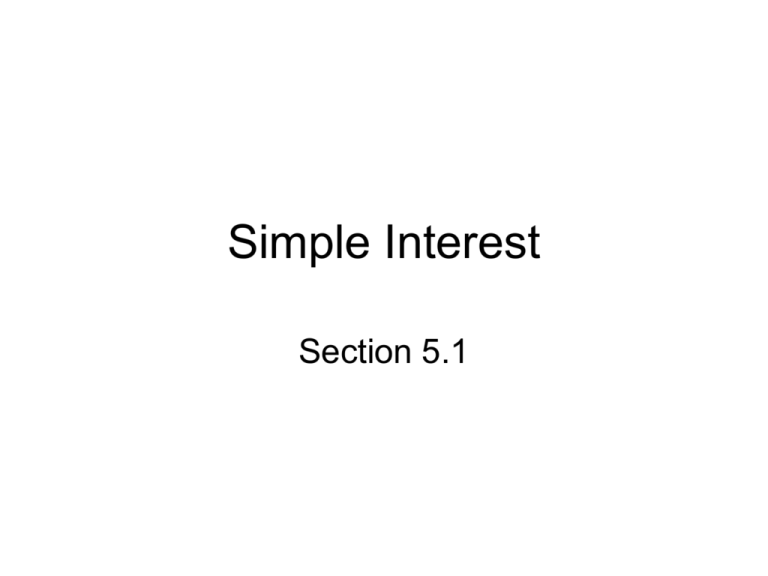
Simple Interest Section 5.1 Introduction • When you deposit money into a savings at a bank you expect the bank to pay you for the privilege of saving your money with them. This is extra money is called interest. • Interest is also paid by a borrower to a lender for the privilege of using money. • In this chapter we study the methods of computing interest. Simple Interest Formula • The simple interest I on a principal (present value) P at an annual interest rate r for t years is I = Prt. • The balance or future value F is given by F = P + I = P + Prt = P(1 + rt). • Example: calculate the simple interest on $1000 deposit at an annual interest rate of 5% for 2 years. • ANSWER: I = ($1000)(.05)(2)=$100. • Also the future value of the investment is F = P + I = $1000 + $100 = $1100. Add – on interest • Add – on interest is a way of calculating interest used by car dealerships, appliance stores, furniture stores etc. • The lender computes the simple interest on the loan amount and adds that on to the loan amount so that the interest is distributed equally over each payment. Add – on interest example • A $1200 flat-screen TV is financed over a 2 year period with 12% add-on interest. Find the monthly payment. • First calculate the simple interest on the loan: $1200 x 0.12 x 2 = $288. • The future value of the loan is $1200 + $288 = $1488. • Since the loan is for 2 years, there will be 24 monthly payments. Thus the monthly payment is $1488/24=$62 Finance Charges • Everyone who has a credit card knows that if they do not pay-off their balance each month they will be assessed a monthly finance charge. How is this computed??? • Credit card companies use the average daily balance. The lender charges interest for the actual number of days an amount was owed on the bill. Example of average daily balance • Let’s look at George W. Bush’s credit card statement. The APR is 21%. • He’s carrying a balance of $287.84. • On June 12 he got an oil change and for his car. This cost $45.60. • He made a payment of $150 on June 18. • He then got gasoline for $20 on June 22. • Then he got some PS-2 games for $78.50 on July 3. Table summarizing the credit card history Time period Day Daily Balance s June 10 – June 11 2 $287.84 $287.84 June 12 – June 17 6 $287.84 + $45.60 $333.44 June 18 – June 21 4 $333.44 – $150.00 $183.44 June 22 – July 2 11 $183.44 + $20.00 $203.44 July 3 – July 9 7 $203.44 + $78.50 $281.94 Doing the calculations • Avg. Daily Balance = [2(287.84)+6(333.44)+4(183.44)+11(203.44)+7(281.94)]/ (2 + 6 + 4 + 11 + 7) ADB = 7521.50/30 = $250.72 • Instead of using the annual percentage rate (APR), we use the daily percentage rate for this account which is .21/365. Also the time will be measured in days hence t = 30. Use the simple interest formula to compute the finance charge. • Finance charge = 250.72 x (.21/365) x 30 = $4.33 • The new balance on W’s credit card will be $281.94 + $4.33 = $286.27
